
(A note on run times: The run times from each cartoon are taken from one of the many public domain DVD releases currently on the market. It is possible that they may be off by a second or two due to clipping of the opening and closing credits or slight loss of footage through truncation of the end title card.)
10. Japoteurs
Release Date: September 18, 1942
Story by Carl Meyer, Bill Turner
Animation by Nick Tafuri, Myron Waldman
Musical Arrangement: Winston Sharples, Sammy Timberg
Directed by Seymour Kneitel
Running Time: 8:52
 Synopsis: The world’s largest plane, so big it can act as a carrier for smaller fighter planes, has been completed and is ready for its first test flight. Hoping for an inside scoop, Lois stows away on board. However, Japanese spies have also stowed away. Once the plane is airborne the spies overpower the crew and steal the plane, bombing the runway behind them to discourage pursuit. Clark changes to Superman and gives pursuit. When the spies realize that they are no match for Superman, they smash the controls of the plane hoping that Superman will be too busy saving the plane to capture them. However, Superman manages to capture the spies, rescue the crew and land the plane safely.
Synopsis: The world’s largest plane, so big it can act as a carrier for smaller fighter planes, has been completed and is ready for its first test flight. Hoping for an inside scoop, Lois stows away on board. However, Japanese spies have also stowed away. Once the plane is airborne the spies overpower the crew and steal the plane, bombing the runway behind them to discourage pursuit. Clark changes to Superman and gives pursuit. When the spies realize that they are no match for Superman, they smash the controls of the plane hoping that Superman will be too busy saving the plane to capture them. However, Superman manages to capture the spies, rescue the crew and land the plane safely.
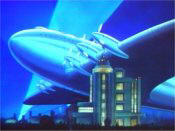 Notes:
Notes:
- This cartoon’s title card is plain, with no special enhancements.
- At five stories tall, the props on the plane look awfully small to get it airborne.
- Unlike the Native American scientist in Electric Earthquake, the Japanese saboteurs, with their thick glasses and buck teeth are very much a racial stereotype. When viewing this cartoon, as well as Eleventh Hour, Destruction, Inc and Jungle Drums, one should keep in mind that they were released during war time when the demonization of the country’s enemies in the Axis powers, particularly in cartoon shorts, was accepted.
- Budd Collyer contributed the voice of the Japanese Hijacker while Jack Mercer supplied the voice of the Press Tour Guide.
11. Showdown
Release Date: October 16, 1942
Story by Jay Morton
Animation by Steve Muffati, Graham Place
Musical Arrangement: Winston Sharples, Sammy Timberg
Directed by Izzy Sparber
Running Time: 8:02
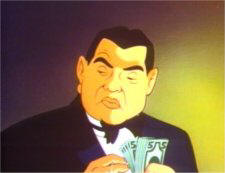 Synopsis: Bank robberies are being committed across Metropolis and it appears as if Superman is committing them! Of course, we soon learn the truth as “Superman” enters a large mansion with his loot, only to be revealed as a disguised henchman for a local crime boss who has planned the whole deception. Back at the Daily Planet, Lois insists on Superman’s innocence. However, rather than be allowed to chase the story, Lois and Clark are assigned to cover the opening of a new opera. Luck favors the reporters when the fake Superman arrives at the theater to rob the patrons. Lois scuffles with the imposter, ripping off the “S”-shield from his costume. Meanwhile, Clark slips away and changes into Superman, confronting his doppelganger on the roof of the theater. The crook convinces Superman that he’ll give up his boss and Superman flies him to the crime bosses home. However, the crook is attempting to lead Superman into and trap and while he is confronting the crime boss, a button is pushed, dropping Superman through a trap door down a pit into an underground river. The crooks make their escape while Superman climbs up out of the pit. Climbing out of the pit, Superman flies after the crooks getaway car, capturing them in time to hand over to the arriving police.
Synopsis: Bank robberies are being committed across Metropolis and it appears as if Superman is committing them! Of course, we soon learn the truth as “Superman” enters a large mansion with his loot, only to be revealed as a disguised henchman for a local crime boss who has planned the whole deception. Back at the Daily Planet, Lois insists on Superman’s innocence. However, rather than be allowed to chase the story, Lois and Clark are assigned to cover the opening of a new opera. Luck favors the reporters when the fake Superman arrives at the theater to rob the patrons. Lois scuffles with the imposter, ripping off the “S”-shield from his costume. Meanwhile, Clark slips away and changes into Superman, confronting his doppelganger on the roof of the theater. The crook convinces Superman that he’ll give up his boss and Superman flies him to the crime bosses home. However, the crook is attempting to lead Superman into and trap and while he is confronting the crime boss, a button is pushed, dropping Superman through a trap door down a pit into an underground river. The crooks make their escape while Superman climbs up out of the pit. Climbing out of the pit, Superman flies after the crooks getaway car, capturing them in time to hand over to the arriving police.
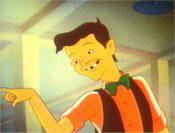 Notes:
Notes:
- Title Card: We see the shadow of a hand holding a revolver lift up into frame. Although a shot rings out, we see no corresponding action from the shadow.
- An uncredited Jack Mercer supplied the voice of the office boy.
- Despite some fan’s insistence, the bow-tied office boy is not intended to be Jimmy Olsen.
- The crime boss bears an uncanny resemblance to “Scarface” Al Capone.
- Since he known to be able to “leap over tall buildings,” it seems that the gangster’s use of the trap door on Superman isn’t very well thought out. Then again, Superman climbs out of the pit instead of flying.
12. Eleventh Hour
Release Date: November 20, 1942
Story by Carl Meyer, Bill Turner
Animation by Willard Bowsky, William Henning
Musical Arrangement: Winston Sharples, Sammy Timberg
Directed by Dan Gordon
Running Time: 7:49
 Synopsis: Eleven o’clock. Yohohama. An unfinished battleship slips out of dry dock and sinks in the bay. Searchlights stab the sky and a brief of glimpse of Superman, streaking away from the scene of the sabotage, is glimpsed by the Japanese soldiers. Under cover of darkness, Superman flies to a hotel room, where he replaces the bars on the window before changing back into Clark Kent. Clark and Lois have been in Japan for several weeks, interred while trying to cover the war. Lois asks Clark if he knows what is causing the commotions they hear each night from their rooms, but Clark feigns ignorance. The nightly super-sabotage continues, with battleships being pulled under water, bridges being demolished and airfields and roads being destroyed. One night, while looking out her window, Lois catches a glimpse of Superman. Her excitement cut short when she is taken hostage by soldiers. Soon warnings are posted throughout the city addressed to Superman. If attempts any more sabotage, Lois will be executed immediately. The next evening Superman drags another partially built ship out of drydock to sink in the bay. Unfortunately, he is caught under the resulting collapse of the dock and is knocked unconscious. As Lois is lead before a firing squad, Superman regains consciousness and sees the warnings that could lead to Lois’s execution. Flying swiftly, he rescues Lois from a hail of gunfire in the nick of time, flying her to safety. On a boat home, Lois tells her fellow reporters that Clark was unfortunately still detained in Tokyo. And the nightly occurrences of super-sabotage continue…
Synopsis: Eleven o’clock. Yohohama. An unfinished battleship slips out of dry dock and sinks in the bay. Searchlights stab the sky and a brief of glimpse of Superman, streaking away from the scene of the sabotage, is glimpsed by the Japanese soldiers. Under cover of darkness, Superman flies to a hotel room, where he replaces the bars on the window before changing back into Clark Kent. Clark and Lois have been in Japan for several weeks, interred while trying to cover the war. Lois asks Clark if he knows what is causing the commotions they hear each night from their rooms, but Clark feigns ignorance. The nightly super-sabotage continues, with battleships being pulled under water, bridges being demolished and airfields and roads being destroyed. One night, while looking out her window, Lois catches a glimpse of Superman. Her excitement cut short when she is taken hostage by soldiers. Soon warnings are posted throughout the city addressed to Superman. If attempts any more sabotage, Lois will be executed immediately. The next evening Superman drags another partially built ship out of drydock to sink in the bay. Unfortunately, he is caught under the resulting collapse of the dock and is knocked unconscious. As Lois is lead before a firing squad, Superman regains consciousness and sees the warnings that could lead to Lois’s execution. Flying swiftly, he rescues Lois from a hail of gunfire in the nick of time, flying her to safety. On a boat home, Lois tells her fellow reporters that Clark was unfortunately still detained in Tokyo. And the nightly occurrences of super-sabotage continue…
Notes:
- Title Card: An ominous clock chimes.
- Jack Mercer supplied the voice for the Japanese Guard, Japanese Official and the American Reporter.
- This is probably the darkest in tone of all 17 Superman cartoons.
- There are two shots reused from The Bulleteers, one of a searchlight being moved into position and one of two rifles behind a wall of sandbags. Both shots have been tinted darker.
13. Destruction, Inc.
Release Date: December 25, 1942
Story by Jay Morton
Animation by Thomas Moore, David Tendlar
Musical Arrangement: Winston Sharples, Sammy Timberg
Directed by Izzy Sparber
Running Time: 8:20
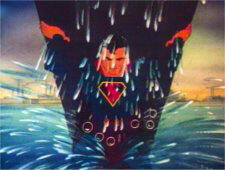 Synopsis: The body of an elderly Metropolis Munitions Plant watchman is discovered in the marshland outside the city. Lois suspects that there’s a story to be found at the plant and goes undercover there as a worker. There she overhears a plan to destroy the factory, but is caught eavesdropping. As the crooks place a bound and gagged Lois into a torpedo casing, they are discovered by a gray-haired watchman. Before the watchman can act, a pile of scrap metal is dropped on him from an overhead magnetic crane by one of the thugs. The torpedo containing Lois is then taken by the thugs out to a firing range, where it is to be shot at a rusty old hulk. Meanwhile, back in the plant, the pile of scrap metal shifts to reveal that the gray-haired watchman was really Superman in disguise. He flies to the testing range and stops the torpedo containing Lois from slamming into its target. Freeing her from the torpedo, Lois tells Superman of the plan to destroy the munitions factory, which he swiftly foils.
Synopsis: The body of an elderly Metropolis Munitions Plant watchman is discovered in the marshland outside the city. Lois suspects that there’s a story to be found at the plant and goes undercover there as a worker. There she overhears a plan to destroy the factory, but is caught eavesdropping. As the crooks place a bound and gagged Lois into a torpedo casing, they are discovered by a gray-haired watchman. Before the watchman can act, a pile of scrap metal is dropped on him from an overhead magnetic crane by one of the thugs. The torpedo containing Lois is then taken by the thugs out to a firing range, where it is to be shot at a rusty old hulk. Meanwhile, back in the plant, the pile of scrap metal shifts to reveal that the gray-haired watchman was really Superman in disguise. He flies to the testing range and stops the torpedo containing Lois from slamming into its target. Freeing her from the torpedo, Lois tells Superman of the plan to destroy the munitions factory, which he swiftly foils.
Notes:
- Title Card- The title streaks up from a distant explosion.
- This is the first Superman short to clearly state that the setting for the cartoons is Metropolis.
- Jackson Beck contributes the voice of the Chief Thug while Jack Mercer supplies the voice of the Radio Newscaster and Louis.
- Although some claim that Lois’ skirt switches from blue to green in a few shots, the color change is actually due to her moving through shadowy and brightly lit areas.
- Although Lois can readily see through Clark’s disguise as the gray-haired watchman at the end of the cartoon, she never realizes that Clark and Superman are one and the same.
- Louis the Cabbie is yet another bad attempt to inject a comic relief character into the series, much in the same vein as Showdown‘s Office Boy. Louis’ use of malapropisms recalls the Bowery Boy’s Leo Gorcey.
14. The Mummy Strikes
Release Date: February 19, 1943
Story by Jay Morton
Animation by Graham Place, Mayron Waldman
Musical Arrangement: Winston Sharples, Sammy Timberg
Directed by Izzy Sparber
Running Time: 7:35
 Synopsis: When Egyptologist Dr. Jordan is found dead, his assistant Jane Hogan is accused of murder and found guilty. Clark Kent receives a phone call from one of Dr. Jordan’s collegues at the museum, a Dr. Wilson, who claims that he has discovered something that would exonerate Jane Hogan. Clark goes to meet, trailed by a suspicious Lois Lane. At the museum, Wilson tells Clark about a tablet Jordan discovered that warns of a curse on the tomb of the pharaoh King Tush. In a section of the museum Wilson shows Clark the faithful reconstruction of Tush’s burial vault that Jordan had built. He also tells Clark the story of the Tush, a boy pharaoh who died young and whose guards swore an oath to always protect him, in this life and in the afterlife. Wilson believes that Jordan was attempting to re-animate Tush’s mummified guards with an Egyptian “Fluid of Life” and was killed by the curse for violating Tush’s tomb. Clark examines the sarcophagus and discovers that the curse is in actuality a hidden needle containing poison. At that moment, the mummified guards come to life, attacking Clark, Wilson and Lois, who is watching Clark and Wilson from the shadows. In the confusion, Clark manages to change into Superman and save Wilson and Lois from the mummies. Back at the Daily Planet, Clark files the news story about Jane’s acquittal.
Synopsis: When Egyptologist Dr. Jordan is found dead, his assistant Jane Hogan is accused of murder and found guilty. Clark Kent receives a phone call from one of Dr. Jordan’s collegues at the museum, a Dr. Wilson, who claims that he has discovered something that would exonerate Jane Hogan. Clark goes to meet, trailed by a suspicious Lois Lane. At the museum, Wilson tells Clark about a tablet Jordan discovered that warns of a curse on the tomb of the pharaoh King Tush. In a section of the museum Wilson shows Clark the faithful reconstruction of Tush’s burial vault that Jordan had built. He also tells Clark the story of the Tush, a boy pharaoh who died young and whose guards swore an oath to always protect him, in this life and in the afterlife. Wilson believes that Jordan was attempting to re-animate Tush’s mummified guards with an Egyptian “Fluid of Life” and was killed by the curse for violating Tush’s tomb. Clark examines the sarcophagus and discovers that the curse is in actuality a hidden needle containing poison. At that moment, the mummified guards come to life, attacking Clark, Wilson and Lois, who is watching Clark and Wilson from the shadows. In the confusion, Clark manages to change into Superman and save Wilson and Lois from the mummies. Back at the Daily Planet, Clark files the news story about Jane’s acquittal.
Notes:
- Title Card: There are no special enhancements to this cartoon’s title card.
- Jackson Beck provided the voice of the Professor.
- The evidence shown at Jane Hoagn’s trial is spurious at best. Although the prosecutor states that Jane’s fingerprints were on the syringe, a simple lab test should have shown that the fluid inside wasn’t the poison that killed Dr. Jordan.
- The name King Tush is obviously a play on the pharaoh King Tutankhamen or King Tut.
- This cartoon is as close to fantasy as the series ever strays. Although there is a rational explanation for the mummy’s “curse”, i.e. the needle, a serum that reanimates the dead is at odds with the more science-fiction elements of the rest of the series.
- The fire pit that the one mummy attempts to throw Lois and Wilson into seemingly appears out of nowhere. Since it is not established earlier, its appearance is jarring.
- It sounds as if Clark is voiced by Sam Parker (Lemuel Gulliver from the Fleischer’s Gulliver’s Travels) in the last scene of the cartoon. It is unknown if and why there was a substitution.
- The bandages on Lois’ arms in the final scene seem to be there only to facilitate her “My mummy done told me” joke. Her time near the fire pit doesn’t seem long enough to allow for her to be burned.
- This cartoon is the only time Clark beats Lois to a story.
15. Jungle Drums
Release Date: March 26, 1943
Story by Robert Little, Jay Morton
Animation by Orestes Calpini, H. C. Ellison
Musical Arrangement: Winston Sharples, Sammy Timberg
Directed by Dan Gordon
Running Time: 7:46
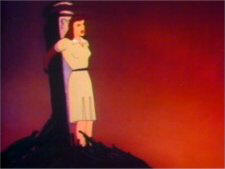 Synopsis: Deep in the jungle, the Germans have built a spy base disguised as a native temple. When an Allied plane is shot down by the base’s guns, its pilot, Lt. Fleming, is killed in the crash, but not before giving the plane’s other passenger, Lois Lane, some vital documents containing orders for a naval convoy the Germans are hunting. She is then captured by soldiers from the base, but not before hiding the papers in the jungle. Resisting torture, the base commander orders Lois to be burned at the stake as part of a native ritual. As the flames begin to climb towards her, the base commander is informed that the papers Lois hid have been found and he goes to radio for a submarine attack on the Allied convoy. Meanwhile, a second plane, carrying Clark Kent, flies overhead and spies the temple and Fleming’s downed plane. Clark parachutes into the jungle. There he changes into Superman and rescues Lois from the flaming pyre. While Superman fights the Nazi soldiers, Lois radios an Allied airfield which dispatches planes that bomb the Axis submarine group to smithereens. Back in Berlin, an angry Adolph Hitler hears the news of his forces defeat via Armed Forces Radio.
Synopsis: Deep in the jungle, the Germans have built a spy base disguised as a native temple. When an Allied plane is shot down by the base’s guns, its pilot, Lt. Fleming, is killed in the crash, but not before giving the plane’s other passenger, Lois Lane, some vital documents containing orders for a naval convoy the Germans are hunting. She is then captured by soldiers from the base, but not before hiding the papers in the jungle. Resisting torture, the base commander orders Lois to be burned at the stake as part of a native ritual. As the flames begin to climb towards her, the base commander is informed that the papers Lois hid have been found and he goes to radio for a submarine attack on the Allied convoy. Meanwhile, a second plane, carrying Clark Kent, flies overhead and spies the temple and Fleming’s downed plane. Clark parachutes into the jungle. There he changes into Superman and rescues Lois from the flaming pyre. While Superman fights the Nazi soldiers, Lois radios an Allied airfield which dispatches planes that bomb the Axis submarine group to smithereens. Back in Berlin, an angry Adolph Hitler hears the news of his forces defeat via Armed Forces Radio.
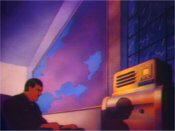 Notes:
Notes:
- Title Card- The sound of jungle drums
- Jackson Beck voiced the German Commander and Jack Mercer played the pilot Lt. Fleming.
- The guns that protrude out of the temple’s statues seem to move at impractical if not impossible angles to the statues’ interiors.
16. Underground World
Release Date: June 18, 1943
Story by Jay Morton
Animation by Reuben Grossman, Nick Tafuri
Musical Arrangement: Sammy Timberg
Directed by Seymour Kneitel
Running Time: 7:54
 Synopsis: A scientist by the name of Henderson convinces the Daily Planet to finance an expedition into a series of caverns discovered by his father, with Clark Kent and Lois Lane to cover the story. Lois and Henderson head into the caverns first, with Clark to follow on a second barge with their supplies. Landing on the shore of an underground lake, Lois and Henderson loose their barge to the current. Lois and Henderson, meanwhile, are captured by a race of birdmen who live in the underground cavern system and brought before their leader. Above the leader’s head is a statue of Henderson’s father, who had disappeared while exploring the caverns 40 years earlier. Lois and Henderson soon find out that it is not a statue but Henderson’s father encased in solid gold, a fate they will soon share. Clark arrives on the scene and changes into Superman. After fighting off some attacking birdmen, he rescues Lois and Henderson from being dropped into a pit of molten gold. Flying them to a cavern closer to the surface, Superman throws dynamite at the pursuing birdmen, collapsing the cavern in front of them, sealing them underground. Later, at the Daily Planet, Perry White refuses to run Lois’ story saying that no one would ever believe it.
Synopsis: A scientist by the name of Henderson convinces the Daily Planet to finance an expedition into a series of caverns discovered by his father, with Clark Kent and Lois Lane to cover the story. Lois and Henderson head into the caverns first, with Clark to follow on a second barge with their supplies. Landing on the shore of an underground lake, Lois and Henderson loose their barge to the current. Lois and Henderson, meanwhile, are captured by a race of birdmen who live in the underground cavern system and brought before their leader. Above the leader’s head is a statue of Henderson’s father, who had disappeared while exploring the caverns 40 years earlier. Lois and Henderson soon find out that it is not a statue but Henderson’s father encased in solid gold, a fate they will soon share. Clark arrives on the scene and changes into Superman. After fighting off some attacking birdmen, he rescues Lois and Henderson from being dropped into a pit of molten gold. Flying them to a cavern closer to the surface, Superman throws dynamite at the pursuing birdmen, collapsing the cavern in front of them, sealing them underground. Later, at the Daily Planet, Perry White refuses to run Lois’ story saying that no one would ever believe it.
 Notes:
Notes:
- Title Card: In the background is an underground cavern with a magnificent waterfall.
- Jackson Beck supplied the voice for Henderson.
- This is the second time that the Daily Planet editor is referred to as Mr. White.
- While this cartoon offers a unique chance for Superman to fight an opponent mid-air, the birdmen fight Superman on a cavern ledge instead.
- It is hard to believe that in a city protected by the likes of Superman, a newspaper editor would find Lois’ story unbelievable.
17. Secret Agent
Release Date: July 30, 1943
Story by Carl Meyer
Animation By Otto Feuer, Steve Muffati
Musical Arrangement: Sammy Timberg
Directed by Seymour Kneitel
Running Time: 7:25
 Synopsis: While Clark Kent is stopped at a drug store phoning the Daily Planet offices, a car smashes through the front window of the store. The driver, a pretty blond woman, hopes out of the car and steals Clark’s car. She is being followed by several men in a dark sedan, who open fire as she attempts to flee. Clark hops on to the back of the sedan and stops the men from open firing on a police car that has also joined the chase. The woman eludes her pursuers but is stopped by the police. She demands that she be taken to headquarters immediately. Meanwhile, Clark has been taken to the men’s hideout, where feigning unconsciousness, he discovers that the men are German agents intent on the blond. At police headquarters, the blond reveals that she is a special agent who infiltrated the German agents’ gang and has a wealth of information on their upcoming plans of sabotage. The police provide an escort to the airport. However, the German agents are waiting for the police escort and ambush them. The agent roars away from the ambush in one of the police cars, only to be trapped on a rotating bridge by two more of the German agents. When she tries to reset the bridge’s controls, she is knocked over into the bridge’s giant gears. Deciding he’s hear enough of the villains’ plans, Clark changes to Superman and traps the German agents’ leader in an elevator before rescuing the blond agent from the approaching gears of the bridge. Superman then flies her to Washington D.C. to deliver her information.
Synopsis: While Clark Kent is stopped at a drug store phoning the Daily Planet offices, a car smashes through the front window of the store. The driver, a pretty blond woman, hopes out of the car and steals Clark’s car. She is being followed by several men in a dark sedan, who open fire as she attempts to flee. Clark hops on to the back of the sedan and stops the men from open firing on a police car that has also joined the chase. The woman eludes her pursuers but is stopped by the police. She demands that she be taken to headquarters immediately. Meanwhile, Clark has been taken to the men’s hideout, where feigning unconsciousness, he discovers that the men are German agents intent on the blond. At police headquarters, the blond reveals that she is a special agent who infiltrated the German agents’ gang and has a wealth of information on their upcoming plans of sabotage. The police provide an escort to the airport. However, the German agents are waiting for the police escort and ambush them. The agent roars away from the ambush in one of the police cars, only to be trapped on a rotating bridge by two more of the German agents. When she tries to reset the bridge’s controls, she is knocked over into the bridge’s giant gears. Deciding he’s hear enough of the villains’ plans, Clark changes to Superman and traps the German agents’ leader in an elevator before rescuing the blond agent from the approaching gears of the bridge. Superman then flies her to Washington D.C. to deliver her information.
Notes:
- Title Card: The sound of gunfire, tires squealing and a crash can be heard under the music.
- The last Superman cartoon.
- Lois Lane does not appear in this cartoon.
- The secret agent’s voice is probably supplied by Joan Alexander.
- The aerial views of Washington, DC are more detailed that the other backgrounds. It is possible that the backgrounds were traced from photographs.
Back to The Fleischer Cartoons.
Back to the History of the Fleischer Superman Cartoons.

